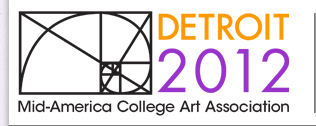Session Title
Creative Process Beyond the Studio
Start Date
4-10-2012 8:00 AM
End Date
4-10-2012 9:30 AM
Session Description
Creative Process Beyond the Studio
In “Creativity: Flow and the Psychology of Discovery and Invention,” psychologist Mihaly Csikszentmihalyi offers the idea that “…creativity does not happen inside people’s heads, but in the interaction between a person’s thoughts and a sociocultural context. It is a systemic rather than an individual phenomenon.”
While it remains natural, for many artists, to focus on their individual part in this creativity equation, creative process can involve, and even invite, influence and participation. Artists may work in teams, or partner with community groups, where they serve as facilitators. Artists may take up the role of instigator, prompting public response and participation. Public artists respond to requests for proposals, frequently addressing issues and conditions specified by project funders and constituents. Indeed, some historical periods of exceptional creative productivity can be linked, as Csikszentmihalyi notes of Renaissance Florence, to the intense involvement of an art patronage structure.
This panel invites considerations of artwork, artists, and creative process that examine and expand our awareness of their “systemic” inter-relatedness. Submissions are sought from artists and designers, curators and organizers, and historians and critics alike.
Updated Participants Aug.
Session List 2.pdf (52 kB)
Updated Abstracts Aug.
Creative Process Beyond the Studio
Creative Process Beyond the Studio
In “Creativity: Flow and the Psychology of Discovery and Invention,” psychologist Mihaly Csikszentmihalyi offers the idea that “…creativity does not happen inside people’s heads, but in the interaction between a person’s thoughts and a sociocultural context. It is a systemic rather than an individual phenomenon.”
While it remains natural, for many artists, to focus on their individual part in this creativity equation, creative process can involve, and even invite, influence and participation. Artists may work in teams, or partner with community groups, where they serve as facilitators. Artists may take up the role of instigator, prompting public response and participation. Public artists respond to requests for proposals, frequently addressing issues and conditions specified by project funders and constituents. Indeed, some historical periods of exceptional creative productivity can be linked, as Csikszentmihalyi notes of Renaissance Florence, to the intense involvement of an art patronage structure.
This panel invites considerations of artwork, artists, and creative process that examine and expand our awareness of their “systemic” inter-relatedness. Submissions are sought from artists and designers, curators and organizers, and historians and critics alike.

